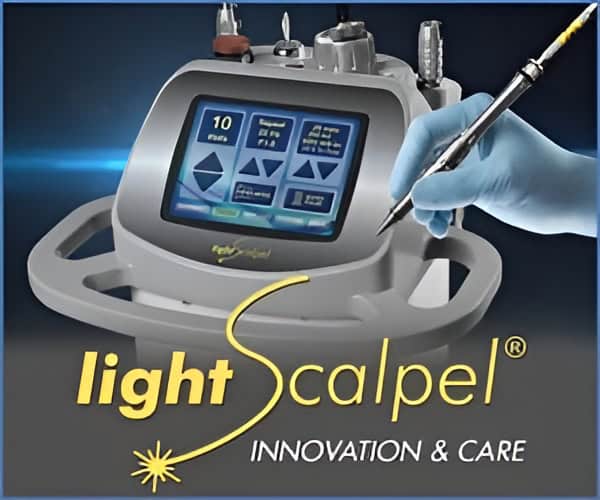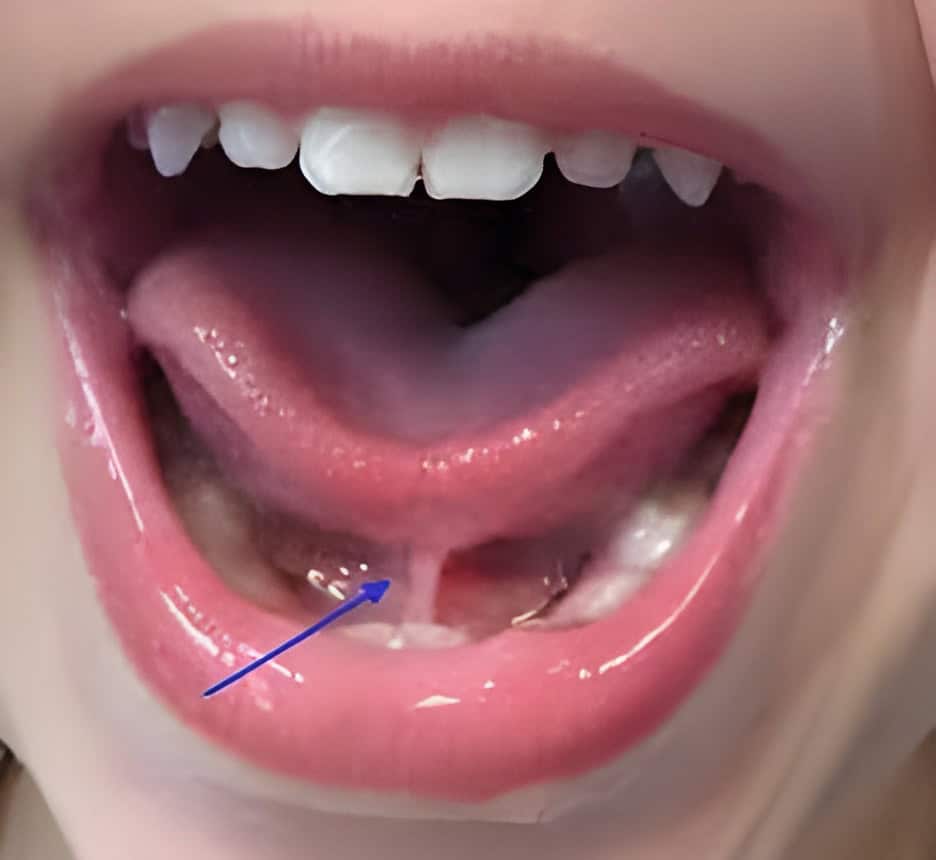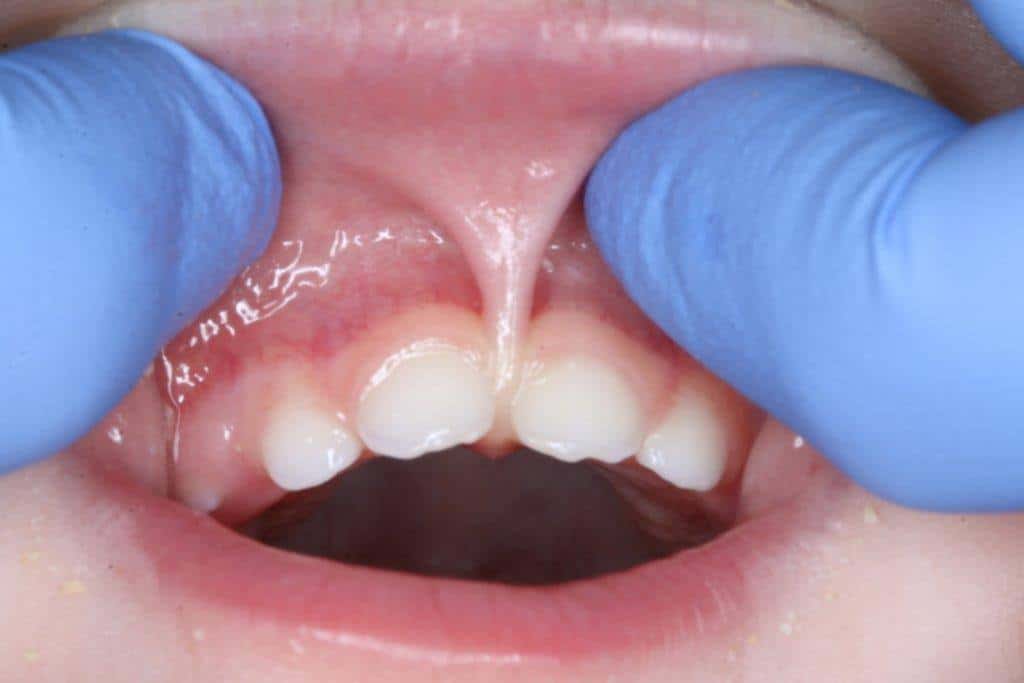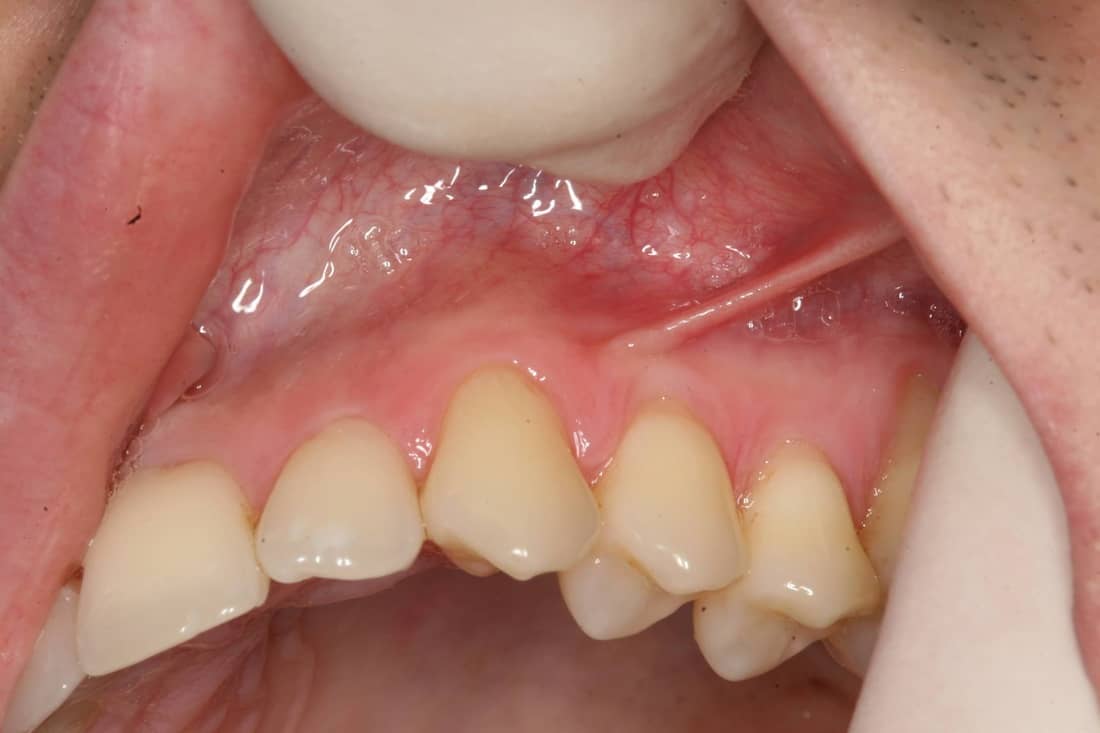Looking for an effective solution to treat tongue tie? At the TMJ Sleep and Breathe Center, diagnosis and treatment of tongue and lip ties is important to correcting mouth breathing, TMJ and Sleep Apnea. Our preferred treatment method is a laser release using the LightScalpel. The LightScalpel Tongue Tie Release, using a CO2 laser, offers precision and minimal discomfort. This article covers the procedure, benefits, and what to expect when having the a release done in our office.

Important Points about Tongue Tie Release with LightScalpel
- Tongue tie, or ankyloglossia, is a congenital condition where a tight lingual frenulum restricts tongue movement, affecting feeding, speech, and jaw development, with a suspected genetic link. Tongue tie also keeps the tongue in the bottom part of the mouth where it can cause mouth breathing, sleep apnea and teeth clenching.
- The LightScalpel Tongue Tie Release procedure uses a CO2 laser for precise, minimally invasive frenectomy, offering benefits like reduced bleeding, quicker recovery, and less postoperative discomfort compared to traditional methods. Other methods use older and more aggressive lasers and metal scalpels.
- Early diagnosis and treatment, including procedures like the LightScalpel and pre- and post-surgical orofacial myofunctional therapy exercises, can significantly improve feeding, speech, and oral health outcomes for individuals with tongue tie.
Understanding Tongue Tie (Ankyloglossia)
Tongue tie, medically known as ankyloglossia, is a condition present at birth that restricts the movement of the tongue due to a tight band of tissue called the lingual frenulum connecting the underside of the tongue to the floor of the mouth. This unusually short, thick, or tight frenulum tethers the tongue, significantly limiting its range of motion and ability to perform essential functions, especially at the tongue’s tip.
The exact cause of tongue tie remains a mystery, but it is believed to have a genetic component, often running in families. Interestingly, it is more commonly observed in boys than girls. This condition can lead to underdevelopment of the upper jaw as the tongue fails to exert the necessary pressure to stimulate growth.
Living with tongue tie can be challenging, especially for infants who struggle with feeding. But it’s not just about infancy; the condition can have lasting effects on speech, airway, sleep, and overall health and quality of life. Comprehending tongue tie’s nature paves the way for pursuing suitable treatment and regaining normal functionality.

Symptoms and Signs of Tongue Tie
Early detection of tongue tie symptoms can be pivotal in effectively managing the condition. Some common signs to look out for include:
- Newborns struggling with breastfeeding or bottle-feeding
- Difficulty latching properly, resulting in poor weight gain
- Burping, stomach gas and reflux
- Frustration for both the infant and the mother
- The baby’s tongue appearing notched or heart-shaped when they try to extend it
- mouth breathing
If you notice any of these symptoms in your infant or toddler, it is important to seek medical attention for further evaluation and potential treatment. The LightScalpel may be the answer.
As children grow older, other symptoms become more apparent. Crowded teeth, mouth breathing, poor sleep, bed wetting and ADHD like symptoms. These can include challenges in articulating certain sounds, leading to speech issues, and problems maintaining oral hygiene, which can result in dental problems like tooth decay, especially in the upper teeth. Awareness of these indications can facilitate swift intervention, potentially mitigating prolonged complications.
Orthodontic Problems
People with tongue tie can have issues with crooked and crowed teeth. Also there may be bite problems such as crossbite, deep bite, over bite and under bite. The issues with the teeth relate to there not being enough room in the mouth for the teeth to fit. As a result the teeth come into the mouth in the wrong place and do not bite well.
The use of palatal expanders and myofunctional therapy is very helpful along with treatment of tongue and lip tie releases with the LightScalpel.
Feeding Challenges
For many parents, feeding a tongue-tied baby can be a daunting task. The condition interferes with breastfeeding due to restricted tongue movement, making it hard for babies to latch deeply or stay latched during feeding. This often leads to milk leaking from the corners of the baby’s mouth and poor weight gain due to inadequate milk intake. Mothers may also experience nipple pain, damaged nipples, and frequent engorgement as signs of the baby’s struggle with their baby’s mouth and baby’s tongue.
The feeding issues don’t stop at breastfeeding. Tongue-tied babies may also have trouble with bottle feeding, often gumming or chewing at the nipple instead of rhythmic sucking. Frequent clicking noises during feeding can indicate lost suction due to the baby’s inability to maintain a proper latch. While these challenges may seem daunting, their early identification can lead to interventions that transform feeding into a more positive experience for both the baby and mother.
Speech and Dental Issues
As children with tongue tie grow, the restricted tongue movement can lead to significant speech and dental issues. Articulation problems are common, as the tongue’s limited range of motion makes it difficult to produce certain sounds clearly. For older children, doctors and speech-language pathologists often listen for difficulties with specific sounds to identify the presence of a tongue tie.
Dental problems are another concern. Tongue-tied individuals may struggle with maintaining oral hygiene, leading to tooth decay and gingivitis due to the inability to sweep food debris from their teeth effectively. These problems underscore the need for prompt diagnosis and treatment to avoid long-term complications and secure optimal oral health.
Diagnosing Tongue Tie
Diagnosing tongue tie involves a careful examination of the lingual frenulum to see if it restricts the movement of the tongue. For older children, the diagnosis might also include listening to their speech to identify difficulties with certain sounds. This thorough approach ensures that the condition is accurately identified and appropriately addressed.
Specialists such as:
- ENT doctors
- Myofunctional Therapists
- Pediatric dentists
- Dentists
- Lactation consultants
- Speech language pathologist
Play a crucial role in diagnosing tongue tie. Their expertise assists in devising a holistic treatment plan catered to the patient’s specific needs, ensuring the best possible outcomes.
What Is LightScalpel Tongue Tie Release?
LightScalpel Tongue Tie Release represents a significant advancement in the treatment of tongue tie. This procedure utilizes a CO2 laser, known for its precision and minimal thermal impact, to perform frenectomy procedures. The benefits of using the CO2 laser for tongue tie release include:
Accurate removal of the restrictive tissue
More effective and less invasive treatment compared to traditional methods
Minimal thermal impact on surrounding tissues
Reduced risk of bleeding and infection
Faster healing and recovery time
With the use of the CO2 laser, tongue tie release can be performed with greater precision and improved outcomes for patients.
One of the key advantages of the LightScalpel procedure is that it usually does not require suturing of the wound. This means a quicker recovery and less discomfort for the patient, making it an attractive option for both parents and healthcare providers seeking an efficient solution to tongue tie.

Lip Tie
Preparing for LightScalpel Tongue Tie Release
Preparation for the LightScalpel tongue tie procedure commences with an exhaustive physical examination by a pediatrician. This exam is crucial for identifying any underlying causes of breastfeeding difficulties and may involve consultations with a lactation consultant. The pediatrician will discuss the benefits and risks of the frenotomy procedure to ensure that parents are well-informed and comfortable with the upcoming treatment.
In addition to the physical exam, pre-surgical orofacial myofunctional therapy (OMT) exercises are recommended to tone the muscles and prepare for the release procedure. These exercises help in optimizing the outcome of the surgery by ensuring that the muscles are ready to adapt to the new tongue movement post-procedure. Some recommended OMT exercises, including tongue exercises, are:
- Tongue stretches
- Lip exercises
- Cheek exercises
- Swallowing exercises
By incorporating these exercises into your pre-neck surgery routine, you can enhance the effectiveness of the surgical treatment and improve overall outcomes.
The LightScalpel Procedure
The LightScalpel procedure is executed with a CO2 laser, offering precision in tissue removal, minimal discomfort, and a blood-free operating field. Both topical and local anesthetics are used to ensure the patient’s comfort throughout the procedure. A protective eye shield is also employed to safeguard the baby’s eyes from the laser.
The use of the CO2 laser offers several advantages:
Enhanced precision
Minimized thermal impact on surrounding tissues
Less postoperative pain
Quicker recovery
These benefits make the LightScalpel procedure a preferred choice for many healthcare providers.

During the Procedure
During the LightScalpel Tongue Tie Release, the following steps are typically followed:
- The baby is swaddled to prevent movement and ensure safety.
- Topical anesthesia is applied to the area to numb the frenulum.
- The CO2 laser is used to photo-thermally cut and coagulate the tissue, ensuring a precise and effective release.
These steps allow for real-time assessment of tongue movement without restriction.
The procedure itself is relatively quick, often taking just a few minutes. The benefits of using a laser for the procedure include:
- Coagulating small blood vessels during the cut, resulting in a bloodless operating field
- Simplifying immediate post-procedure care
- Enhancing patient comfort
Post-Procedure Care
Post-procedure care is vital for a seamless recovery. Parents are encouraged to feed their babies immediately after the procedure to soothe them and promote healing. Monitoring the baby’s pain levels and administering appropriate pain relief, such as infant acetaminophen, can help manage any discomfort.
To prevent the reattachment of the frenulum, parents are advised to perform gentle stretching exercises with the baby’s tongue. These exercises are essential for maintaining the increased range of motion achieved through the procedure and ensuring long-term success.
Benefits of LightScalpel Over Traditional Methods
The LightScalpel CO2 laser provides myriad advantages over conventional tongue tie release methods. Patients undergoing this procedure report:
- Less postoperative pain and discomfort, allowing for a quicker return to normal activities
- Minimized bleeding due to the laser’s ability to cut and coagulate soft tissue simultaneously
- Reduced risk of infection
Furthermore, the LightScalpel procedure is faster than conventional methods, often completed in just 10-20 seconds. This efficiency, combined with the reduced risk of complications, makes the LightScalpel a superior option for treating tongue tie.
Potential Risks and Considerations
Although the LightScalpel procedure is generally safe, awareness of potential risks is crucial. One of the primary concerns is avoiding injury to the glands, ducts, and nerves located under the tongue, especially when treating a posterior tongue tie. Although complications are rare, they can include minor bleeding, damage to salivary glands or tongue muscles, and scarring or reattachment of the frenulum.
These risks underscore the importance of:
- Having the procedure performed by an experienced healthcare provider
- Minimizing potential complications
- Ensuring the best possible outcome for the patient.
Recovery and Aftercare
Patients typically experience a smooth recovery with minimal discomfort and swift healing post a LightScalpel laser frenectomy. Patients are advised to stick to a soft food diet initially to avoid pain and facilitate healing. Follow-up appointments are scheduled about a week after the procedure to monitor recovery and address any concerns.
Ongoing orofacial myofunctional therapy (OMT) exercises and regular follow-ups constitute crucial aspects of long-term care to maintain tongue mobility and prevent frenulum reattachment. These steps are essential for achieving the best possible outcomes and preventing the recurrence of tongue tie.
Immediate Post-Procedure
Immediately after the LightScalpel procedure, feeding the baby is recommended to soothe them and promote healing. Many parents notice an immediate improvement in latch and a reduction in breast pain, making feeding a more comfortable experience for both mother and baby.
Managing pain also plays a significant role in immediate post-procedure care. Over-the-counter pain medication can help manage oral soreness and tenderness, ensuring that the baby remains comfortable as they recover. Monitoring for minor issues like excessive drooling and oral muscle discomfort is also important.

Long-Term Care
Long-term care after a LightScalpel laser frenectomy involves regular follow-up appointments to ensure proper healing and to address any concerns that may arise. At a three-week follow-up, the surgical site typically shows excellent healing, indicating a successful procedure.
Performing small stretches multiple times a day is crucial to prevent the tongue tie from reforming. Additionally, patients may need to relearn how to use their mouth now that the tissues are unrestricted, following a tongue tie treatment.
Some infants might require additional speech therapy assistance to fully benefit from the increased range of motion and enhance their baby’s ability in communication.
Living with Tongue Tie
Although living with tongue tie presents challenges, numerous individuals gradually learn to handle their symptoms. While the condition cannot be outgrown, early intervention and treatment can significantly improve quality of life. Teens and adults who were not treated as children often become self-conscious about their tongues, especially during romantic relationships or when engaging in activities that require precise tongue movements, such as playing wind instruments or kissing.
For those who continue to live with the condition, simple adaptations can make daily activities more manageable. Some examples include:
Cutting food into smaller pieces and placing it further back in the mouth to help with eating
Speech therapy to improve articulation and pronunciation
Seeking support and strategies from professionals like lactation consultants and speech-language therapists for managing tongue tie effectively.

Summary
Tongue tie (ankyloglossia) is a congenital condition that can significantly impact feeding, speech, and dental health. Early diagnosis and treatment are crucial for preventing long-term complications. The LightScalpel Tongue Tie Release offers a modern, effective solution with numerous benefits over traditional methods, including less pain, faster recovery, and reduced risk of infection.
By understanding the symptoms, seeking timely diagnosis, and opting for advanced treatments like LightScalpel, individuals can overcome the challenges posed by tongue tie. Whether it’s a newborn struggling with breastfeeding or an adult dealing with speech issues, there is hope for a better quality of life through proper intervention and care. Remember, addressing tongue tie early can pave the way for a smoother journey and a brighter future.
Frequently Asked Questions
What is tongue tie (ankyloglossia)?
Tongue tie, or ankyloglossia, is a congenital condition that restricts tongue movement due to a tight band of tissue under the tongue.
What are common symptoms of tongue tie?
Common symptoms of tongue tie include feeding difficulties, speech articulation problems, and dental hygiene issues. These can affect both infants and adults.
How is tongue tie diagnosed?
Tongue tie is diagnosed by checking for restricted tongue movement and consulting specialists such as ENT doctors and lactation consultants.
Tongue tie is diagnosed by checking for restricted tongue movement and consulting specialists such as ENT doctors and lactation consultants.
Tongue tie is diagnosed by checking for restricted tongue movement and consulting specialists such as ENT doctors and lactation consultants.
Tongue tie is diagnosed by checking for restricted tongue movement and consulting specialists such as ENT doctors and lactation consultants.
LightScalpel offers benefits such as less pain, faster recovery, minimal bleeding, and reduced risk of infection, making it a favorable option for many individuals.
 703-712-1053
703-712-1053 